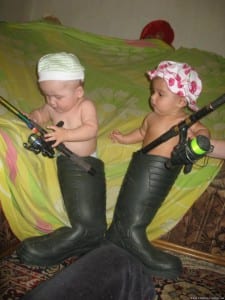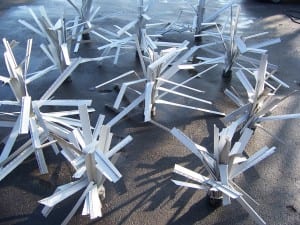Yellow perch study finds correlation between reduced reproduction and increase in impervious surfaces.


A recent study suggests that land development in some watersheds around the Bay is literally paving over yellow perch habitat.
The study of five watersheds found that yellow perch were less likely to produce viable eggs in those with more roads, roofs, parking lots and other impervious surfaces than in those that retain more undeveloped land.
In places like Maryland’s Severn River, which was once a hot spot for yellow perch reproduction, the fish produce almost no viable eggs. Scientists say the culprit is likely increased development that has altered habitats, as well as toxic contaminants entering waterways from stormwater discharges.
“We can’t really explain it except for some combination of development and toxics, which may be two words for the same thing,” said Fred Pinkney, a toxicologist with the U.S. Fish and Wildlife Service’s Chesapeake Bay Field Office in Annapolis, and a co-author of the study.
“This study clearly documents the biology of the yellow perch reproduction problems, but we would need a new study to figure out what chemicals may be the cause,” Pinkney said.
While most Bay cleanup efforts have focused on nutrient reduction, the study highlights the increasing concern of some biologists and fishery managers around the Chesapeake that ongoing development and other pollutants — such as chemical contaminants — are continuing to degrade important fish habitats. Unless those issues are dealt with, they say, the Bay’s fish and shellfish populations could continue to suffer even as nutrient pollution is reduced.
The yellow perch study comes on the heels of a federal report released in January that found widespread evidence that chemical contaminants were affecting fish in the Bay and throughout much of its watershed. “We do have biological effects,” said Vicki Blazer, a fish pathologist with the U.S. Geological Survey, and a co-author of both the toxics report and the yellow perch study. “We have poor reproduction in some tributaries, we have fish kills, we have intersex, we have tumors. So obviously there are issues.”
Meanwhile, the Bay Program’s Sustainable Fisheries Goal Implementation Team, which helps to coordinate Baywide efforts to restore and manage fish populations and is made up of representatives from federal agencies and senior state fishery officials, has increasingly identified development and other land management actions as a major threat to fish populations.
Peyton Robertson, director of the National Oceanic and Atmospheric Administration Chesapeake Bay Office and chair of the Fisheries Goal Team, said it was important to make people aware of the issues, and to address them. “Those issues are difficult and deal with complex interactions between people and the places they live,” he added. “That is one of the challenges we face.”
Presentations at recent meetings of the fisheries team have highlighted how everything from hardened shorelines, to the loss of coastal marshes to increased pavement in upstream areas can impact fish health and productivity.
Those findings recently spurred the fisheries team to take the unusual step of writing to the Charles County Board of Commissioners, expressing concern that new development allowed in the county’s proposed new comprehensive plan could harm Mattawoman Creek and threaten its largemouth bass fishery, shellfish communities and anadromous fish spawning habitats. Because Mattawoman Creek serves as a spawning area and nursery for anadromous fish such as striped bass, alewife and blueback herring, the letter warned that further development in its watershed could have regional implications for some fish populations which are reared in the Bay but spend most of their lives migrating along the coast.
The letter said the draft plan “sets a precedent for unsustainable growth and development over conserving healthy habitats and economically important fisheries.”
Robertson said that it is not the team’s intent to interject itself in regional planning decisions throughout the watershed. But, he said, it is trying to identify other high-quality tidal rivers which, like the Mattawoman, may be particularly important for maintaining regional fish and shellfish populations, and to encourage greater protection for them.
“Fishermen have been basically subsidizing development,” said Jim Uphoff, a fisheries biologist with the Maryland Department of Natural Resources. Development can cause reduced fish production, as has happened with yellow perch in some areas, which results in reduced catch limits to help protect the population, said Uphoff, also a co-author of the new yellow perch study
He was part of a DNR research team that investigated sharply reduced fish production on the Severn River a decade ago. Those studies found that only 10 percent of the eggs produced by yellow perch on the Severn were viable, compared with 90 percent on the Choptank, Nanticoke and Patuxent rivers. It was also significantly less than had been produced in the Severn decades earlier, when it was less developed.
Yellow perch reproduction in the river is so low, Uphoff said, it likely couldn’t produce a sustainable population, even if fishing in the Severn was closed altogether. The DNR allows fishing, but the fish caught are generally those produced in other rivers that have ventured into the Severn.
“When you talk about the type of changes in egg viability that we’ve seen, fisheries harvest management doesn’t have enough leverage to offset the contaminant damage,” Uphoff said. “Essentially, you can’t turn that around by eliminating harvest. So why punish the fishermen for that?”
The new study provides new biological evidence of why the Severn River eggs were not viable by showing that the eggs themselves are deformed — something that strongly suggests chemical contaminants may be contributing to the problem.
The new yellow perch study, conducted from 2007 through 2009, looked at the Severn, the South, the Upper Choptank and the Mattawoman, as well as Allen’s Fresh, a small tributary of the Wicomico River. All had various rates of development: 24.6 percent of the South River watershed was covered by impervious surfaces, compared with 20.7 percent in the Severn; 10.2 percent in the Mattawoman, 4.8 percent in Allen’s Fresh; and 1.7 percent in the Upper Choptank.
In the study, the percentage of egg yolk deformities was significantly higher in the South and the Severn than in the less-developed rivers. The percentage with abnormalities of the zona pellucida, or the envelope that surrounds the eggs, was also highest in those rivers. None of the eggs from Severn females were fully developed at the time of collection in any of the years.
But it is exceedingly difficult to identify what triggered the problem in an area where water flow patterns fluctuate widely and where a witch’s brew of nutrients, pesticides, pharmaceuticals, PCBs, metals and other contaminants enter the water from runoff.
“It probably is not one thing,” Blazer said. “We can’t look at things one chemical at a time anymore, because that is not what organisms are being exposed to. They are being exposed to the whole suite of chemicals. Unfortunately, right now, we have very little information about how they all interact.”
Besides carrying toxic runoff, development has many other impacts, some of which may seem subtle but may be important to aquatic systems. They range from changes in salinity to changes in oxygen concentrations in the water to changes in flow regimes that affect whether food is available to fish larvae when they need it.
And while impacts are seen in fish like yellow perch, scientists say other less heralded species — but ones important to the food web — may be suffering even more. “We aren’t looking at those species because they aren’t commercially or economically important,” Blazer said.
Further, there’s little evidence that stormwater controls — even new practices that promote water infiltration rather than surface runoff — can fully offset the spectrum of impacts from new development on healthy streams. Stormwater projects, Uphoff said, don’t “dissolve all your developmental sins.”
As a rule of thumb, biologists say that aquatic life starts to suffer irreparable harm when more than 10 percent of a watershed is covered by impervious surfaces. Sensitive species can disappear at lower thresholds — in Maryland, brook trout typically disappear when imperviousness hits the 2 percent mark.
Uphoff said the DNR has increasingly been encouraging commercial and recreational fishermen and others to become more engaged in land use issues — particularly in areas that retain particularly valuable habitats — before they get developed. “We tend to think that the best strategy, at least for fisheries, is to work on conserving the places that are still functioning,” Uphoff said.
That is what triggered the fisheries goal team letter concerning the Mattawoman. Its watershed is at the 10 percent impervious mark, which means it could be near a tipping point where more development could impact a variety of fish habitats, including areas used by striped bass, shad and river herring — all of which are Bay Program target species for restoration.
While concerns about habitat degradation caused by development and toxics has worried biologists and fisheries managers, it remains unclear whether those issues will return in a significant way to the Bay Program’s agenda.
Toxics and land use were once key areas of focus for the state-federal Bay Program partnership. But issues related to toxics became overshadowed by nutrient pollution, and efforts to control sprawl development were even less successful — a goal in the Chesapeake 2000 agreement to reduce the rate of harmful sprawl faltered when, after years of debate, the partnership failed to agree on a definition of harmful sprawl.
A 2010 federal Chesapeake Bay restoration strategy called for setting new goals to control toxic pollution this year, but that idea has drawn little enthusiasm from many state officials who are already challenged to meet nutrient reduction goals stemming from the Bay Total Maximum Daily Load.
Nick DiPasquale, director of the EPA’s Bay Program Office, acknowledged that many partners were reluctant to add new commitments. “Dealing with the TMDL is a heavy lift itself,” he said. But he added that it was premature to judge whether the Bay Program could reach agreement on new toxics goals this year. He also noted that even without specific action by the Bay Program, other state and federal programs exist to deal with toxics. More habitat articles at fishiding.com
A summary of the yellow perch study is available on the U.S. Fish and Wildlife Service Chesapeake Bay Field Office website: www.fws.gov/chesapeakebay/.

 Friday, March 8, 2013 at 9:21AM ActivistAngler.com
Friday, March 8, 2013 at 9:21AM ActivistAngler.com



